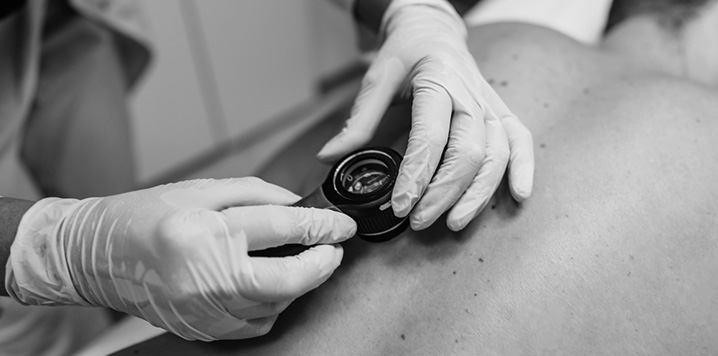Home » General Dermatology » Skin Cancer Screening in NC
Preventative skin cancer screening and treatment at DermaBlue.

Skin cancer is highly treatable when detected early. It is important to regularly examine your skin to see if any spots or moles on the skin are changing, itching, or bleeding. If you have an increased risk or family history of melanoma or skin cancer, you should be sure to have yearly skin checks by a dermatology professional.
The screening with take around 10-15 minutes or longer, depending on whether or not the provider sees any unusual lesions. You will wear a medical gown and the provider will then inspect the skin including the scalp, hands, and feet. The provider will be looking for moles that show signs of cancer such as:
Asymmetry — not the same shape on both sides.
Border Irregularity — ragged burred edges.
Color — different shades of tam, brown, black.
Diameter — larger than ¼ inch.
Evolving — changes over time.
Once the skin has been checked, the doctor will review any findings and let you know if any additional follow up is needed. Any concerning lesions will be biopsied and we will call you in a few days to review the findings. If there are additional treatments you will be scheduled to come into the office. Additional treatments can include:
After a local anesthetic is injected, a surgical knife (scalpel) is used to shave off the growth stitches are not needed. Any bleeding can usually be controlled with a chemical that stops bleeding and by applying pressure. The biopsy site is then covered with a bandage or sterile dressing.
After a local anesthetic is injected, a small, sharp tool that looks like a cookie cutter called a “punch” is placed over the lesion, pushed down, and slowly rotated to remove a circular piece of skin. The skin sample is lifted up with a tool called a “forceps” or a needle and is cut from the tissue below. Stitches may not be needed for a small skin sample. If a large skin sample is taken, one or two stitches may be needed. Pressure is applied to the site until the bleeding stops. The wound is then covered with a bandage or sterile dressing.
After a local anesthetic is injected, the entire lesion is removed with a scalpel. Stitches are used to close the wound. Pressure is applied to the site until the bleeding stops. The wound is then covered with a bandage or sterile dressing. If the excision is large, a skin graft may be needed.
This procedure involves removing a skin cancer one layer at a time and examining these layers under a microscope immediately after they are removed. This procedure allows for a close examination of each layer of skin to detect cancer cells.
Asheville Location
1998 Hendersonville Rd, Unit 53
Asheville, NC 28803
828-585-5489
Hendersonville Location
120 South Grove Street
Hendersonville, NC 28792
828-685-2917
© 2024 DermaBlue. All rights reserved. | Privacy Policy | HIPAA Compliance
NEW PATIENTS GET $50 OFF ANY COSMETIC TREATMENT
Take the first step towards your aesthetic goals with our complimentary 30-minute consultation. Simply fill out the form below and a patient care coordinator will be in touch shortly to help you schedule your consultation.

This website uses cookies to improve user experience. By using our website you consent to all cookies in accordance with our Cookie Policy. We do not sell your data. Read more